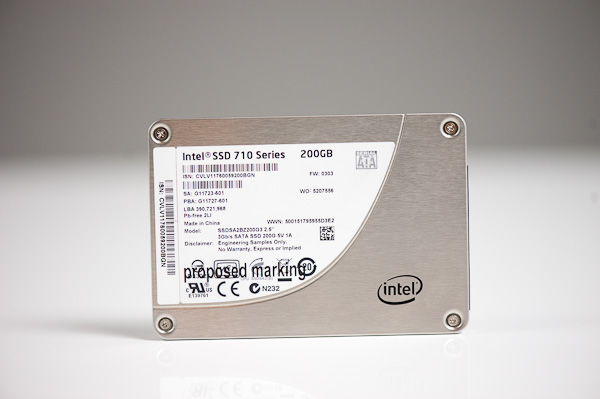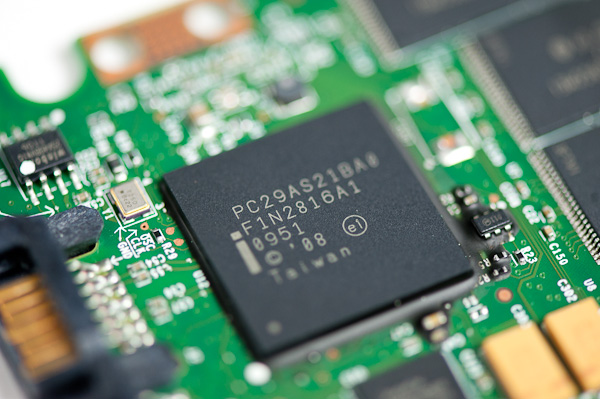The Intel SSD 710 (200GB) Review
by Anand Lal Shimpi on September 30, 2011 8:53 PM EST- Posted in
- Storage
- SSDs
- Intel
- Intel SSD 710
When Intel entered the SSD market one of its declared goals was to bring the technology into the mainstream. The goal was so important to Intel that its consumer drive was branded X25-M, with the M standing for mainstream. Intel's desire for SSD ubiquity wasn't entirely altruistic however. Mechanical storage acted as a potential gate to increasing CPU performance. Eventually, without significant improvements in IO performance, CPU improvements would be less visible to most users. SSDs would help alleviate this bottleneck.
It wouldn't be untrue to say that Intel accomplished its mission. The client SSD market was in a state of disarray before Intel arrived on the scene. Although we still have problems today, there are a number of affordable options for end users and lots of competition. Samsung, Marvell, Indilinx, JMicron and even SanDisk are now vying for control of the market.
With healthy competition, significant performance improvements and (hopefully) improved reliability in the consumer SSD space, Intel will actually begin defocusing itself from this market over the coming years. Intel needs to keep margins as high as possible to appease shareholders, and the consumer SSD business is in a race to the bottom. Dollars per GB are all that matter here once you deliver a certain level of performance and reliability.
Intel won't abandon the consumer SSD market completely, it will still compete in the high end space but there's a good reason that the mainstream moniker has been dropped from Intel's product names. Intel will shift more of its attention to the enterprise space, bringing that technology to the high end desktop/workstation users where it can (e.g. Cherryville will be focused on both enterprise and enthusiast desktop users). But as you have already seen, I wouldn't expect Intel to actively compete in driving mainstream SSD pricing down further. That market now belongs to the players I mentioned above.
What better way to kick off the shift in focus than with a new enterprise drive: Intel's SSD 710, the long awaited successor to the X25-E. Unlike previous Intel SSDs however the 710 isn't aimed at significantly improving performance. Instead the 710 attempts to offer larger capacities than the X25-E, at similar endurance and performance levels. That's right, the 710 shouldn't outperform the X25-E, it'll just be cheaper.
At first glance that's not a very impressive claim. The X25-E came out in 2008 (available in early 2009) and hasn't been updated since. Delivering performance similar to that of a three-year-old SSD doesn't sound all that exciting. If huge performance gains are what you're after, the SSD 710 isn't for you.
The 710 is built off the same architecture as the Intel SSD 320. It uses the same controller but with a newer firmware revision. The firmware is obviously also tuned for enterprise workloads.
| Enterprise SSD Comparison | |||||
| Intel SSD 710 | Intel X25-E | Intel SSD 320 | |||
| Capacities | 100 / 200 / 300GB | 32 / 64GB | 80 / 120 / 160 / 300 / 600GB | ||
| NAND | 25nm HET MLC | 50nm SLC | 25nm MLC | ||
| Max Sequential Performance (Reads/Writes) | 270 / 210 MBps | 250 / 170 MBps | 270 / 220 MBps | ||
| Max Random Performance (Reads/Writes) | 38.5K / 2.7K IOPS | 35K / 3.3K IOPS | 39.5K / 600 IOPS | ||
| Endurance (Max Data Written) | 500TB - 1.5PB | 1 - 2PB | 5 - 60TB | ||
| Encryption | AES-128 | - | AES-128 | ||
| Power Safe Write Cache | Y | N | Y | ||
| Temp Sensor | Y | N | N | ||
Since it uses the same controller as the 320, you get the same benefits. There's still no 6Gbps support, but you do get full disk encryption (enabled via ATA password). Intel also outfits the 710 with capacitors to ensure any data stored in the controller's caches can be committed to NAND in the event of a power failure. The 710 also includes surplus NAND arrays (and data redundancy). In the event of a full NAND die failure, you shouldn't see any data loss.
What Intel promises with the 710 is reliability and a clear upgrade path from the X25-E. The idea here is most enterprise workloads exist on mechanical drives today. Moving to a small array of SSDs quickly alleviates any IO bottlenecks, then the only issues that remain are cost, capacity and reliability. It's the three of these areas that the SSD 710 looks to address.
Don't get too excited about the cost angle though. While the Intel SSD 710 drives cost-per-GB down much lower than the old X25-E, it is still an enterprise drive so expect to pay more than what you'd find as a consumer.
The pricing breakdown is below:
| Intel SSD 710 Pricing Comparison | ||||||
| X25-E 64GB | 100GB | 200GB | 300GB | |||
| Price | $790 | $650 | $1250 | $1900 | ||
| Price per GB | $12.34 | $6.50 | $6.25 | $6.33 | ||
At $6.50/GB the 710 is significantly cheaper than the outgoing X25-E which is still priced at over $11/GB today. When it first launched the X25-E commanded over $15/GB. Regardless of performance, these prices alone are enough to drive away consumers. If you haven't gotten the hint by now, the 710 is strictly for enterprise customers.
Capacities are also significantly higher. While the X25-E topped out at 64GB, the 710 will take you all the way up to 300GB.
Reliability wasn't an issue with the X25-E, thus it mustn't be an issue with the 710 either. There's just one problem: the X25-E could depend on 50nm SLC NAND, boasting an endurance rating of 100,000 program/erase cycles per cell, the 710 however needs to somehow equal that with 25nm MLC NAND. As a reference, consumer-grade MLC NAND is good for 3000 - 5000 p/e cycles.
Why use MLC NAND? The shift to MLC is what gives the 710 its cost and capacity advantages over the X25-E. How does Intel have its cake and eat it too? By using something it calls MLC-HET NAND.












68 Comments
View All Comments
inplainview - Saturday, October 1, 2011 - link
Useless toys? Is this coming from someone that can't afford Apple's offerings or someone who hasn't figured out that Apple is in the mainstream of consumer offerings and mentioning them is this consumer space is quite appropriate considering Apple's influence. You have proven yourself to be myopic and petty.Stas - Sunday, October 2, 2011 - link
umadbro? Everything Apple sucks :Dgevorg - Saturday, October 1, 2011 - link
At least there is no Top 100 iPhone apps here. :)web2dot0 - Friday, September 30, 2011 - link
Unfortunately, that's what people want to read nowdays. Anand is just targeting the mainstream. Otherwise, how will he get all the pageviews? It's a business afterall. Let's not be naive. He doesn't choose his articles to write about by random. There's always a reason to the madness. He's just trying to stay (slightly) ahead of the curve. Too hard out, and it'll become irrelevant.Just wish the team stops writing so many editorial news reporting and focuses more on technical analysis like the ones above. The site is slowly becoming more and more corporate and with time, it will lose it's edge.
Anyways, it's not like other sites are that much better. There's always room for improvement ....
taltamir - Saturday, October 1, 2011 - link
Apple has single digit market-share. This is as far from mainstream as possible.B3an - Saturday, October 1, 2011 - link
....Yeah in computers but thats it. Apple are the largest consumer tech company on the planet, they now make more money than Microsoft. Apple pretty much have a monopoly on MP3 players and online music. They have the single best selling phone, the best selling tablet, and are gaining PC market share. For tech stuff you cant get more mainstream than Apple. There useless devices dont belong on serious sites like this IMO, they belong on dumbed down crap like Engadget.inplainview - Saturday, October 1, 2011 - link
How many of you would be willing to financially support this site so that you can get your truckload of geek? Most likely zero to none. This site is supported via page hits which means that the authors have to write about stuff that most of the basement dwellers here aren't interested in. However, as someone who actually goes out into the sun, knows what women look like, smell like, taste like (figure it out), and realize that there is a world outside of sitting in front of a keyboard and bitching about how this site is not this and that, I can appreciate the work put in. Some of you people are simply whiners and pathetic.Stas - Sunday, October 2, 2011 - link
Apple unofficially owns EngadgetKPOM - Saturday, October 1, 2011 - link
In the US, Apple has the third largest share of the PC market.http://arstechnica.com/apple/news/2011/07/apple-no...
It's lower worldwide, but Apple is definitely a mainstream PC manufacturer.
http://osxdaily.com/2011/03/18/mac-market-share-ar...
Penti - Saturday, October 1, 2011 - link
Anandtech is far from and far more then just a gadget site. Times change and you have to keep up with that to. So of course the focus changes, it's not all about the baddest mainstream overclocking mainboards and high-end gamer gpus any more, things have changed and people come here because it's not just fluff but also digs through down in the hardware/product. You will have more smartphones, notebooks and so on the gpu wars itself won't get you a lot of readers. You will have more enterprise topics and so on. Computing has changed. It's not really about gaming any more and that market has changed.